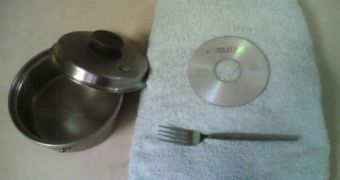Ever had problems with pesky CDs being unable to be read by the CD-ROM drive, due to the fact that the surface was too scratched to be distinguished from the information imprinted in its layers? In the next article, I'll talk about methods of salvaging your precious data.
The CD or Compact Disk, is a optical disk used to store digital data formats, and was originally created as a digital audio storing device. The first CD was created at a Philips factory in Germany, through a collaboration between Philips and Sony. It was first unveiled in March 1979, and since its release on the market in 1982, it remained the standard playback medium for commercial audio recordings.
The mass production process involves the creation of a disk structure of clear plastic, in which a metallic layer (usually aluminum) is inserted. The recordable disks have a 'blank' data spiral moulded, on top of which a photosensitive dye is applied, after which the disks receive a metal layer, and a coat of lacquer. Information is imprinted in the photosensitive dye, with the help of a semiconductor laser, which will change the color of the dye, resulting in a disk that can be read by most of the CD-ROM devices available.
Though the life span of a CD is designed to be somewhere from 20 to 100 years, they mostly depend on the quality of the disks, the writing process, and storing conditions, thus making the reading process a nightmare if the CD suffers degradation. Some testings suggest that after 18 months, some CDs will experience a kind of rotting even under exceptional storing conditions.
If you want to reverse the damage produced by heavy scratches and bring back an unreadable CD, you could use one of the available home repairing methods. While some methods involve polishing the surface layer of the CD, the method which will be presented uses heat to make the surface even.
You will need something to hold the CD over the heating source, such as a fork; a heating device, a pot large enough to house the CD, and a towel. Carefully grab the CD with the help of the fork, so that you would not damage it further.
Light up the gas stove, and place the disk over the flame at a safe distance so you won't burn it. Slowly spin the CD on top of the flame, so that it will evenly heat up. As the disk heats up, you might see a small distortion in its center, around the area you grabbed it with the fork.
To correct this you will need to boil the CD in a pot with about 5 centimeters of water, for 5 minutes. As the water boils, it keeps the disk floating on top of it so you won't need to worry about it touching the hot lower part of the pot. After the 5 minutes pass, you can fish the CD out of the boiling water, and wipe it with a tower, from the center out. The surface should straighten out, and the CD will be as good as new.

 14 DAY TRIAL //
14 DAY TRIAL //